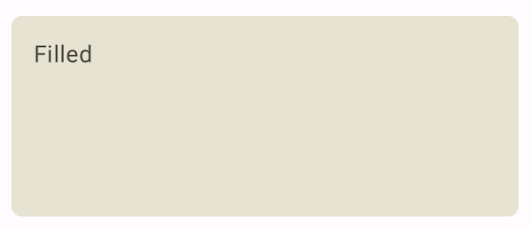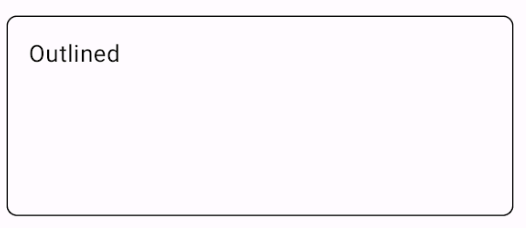Card 컴포저블은 UI의 Material Design 컨테이너 역할을 합니다.
카드는 일반적으로 일관된 콘텐츠를 하나씩 표시합니다. 다음은 카드를 사용할 수 있는 몇 가지 예입니다.
- 쇼핑 앱의 제품
- 뉴스 앱의 뉴스 기사
- 커뮤니케이션 앱의 메시지
Card가 다른 컨테이너와 다른 점은 단일 콘텐츠를 묘사하는 데 중점을 둔다는 것입니다. 예를 들어 Scaffold는 전체 화면에 일반적인 구조를 제공합니다. 카드는 일반적으로 더 큰 레이아웃 내에 있는 더 작은 UI 요소인 반면 Column 또는 Row과 같은 레이아웃 구성요소는 더 간단하고 일반적인 API를 제공합니다.

기본 구현
Card는 Compose의 다른 컨테이너와 매우 유사하게 동작합니다. 내부에서 다른 컴포저블을 호출하여 콘텐츠를 선언합니다. 예를 들어 다음 최소 예시에서 Card에 Text 호출이 포함되는 방식을 살펴보세요.
@Composable
fun CardMinimalExample() {
Card() {
Text(text = "Hello, world!")
}
}
고급 구현
Card의 API 정의는 참조를 확인하세요. 구성요소의 모양과 동작을 맞춤설정할 수 있는 여러 매개변수를 정의합니다.
다음은 유의해야 할 몇 가지 주요 매개변수입니다.
elevation: 구성요소에 그림자를 추가하여 배경 위로 올라간 것처럼 보이게 합니다.colors:CardColors유형을 사용하여 컨테이너와 모든 하위 요소의 기본 색상을 설정합니다.enabled: 이 매개변수에false를 전달하면 카드가 사용 중지된 것으로 표시되고 사용자 입력에 응답하지 않습니다.onClick: 일반적으로Card는 클릭 이벤트를 허용하지 않습니다. 따라서 주목할 기본 오버로드는onClick매개변수를 정의하는 오버로드입니다.Card구현이 사용자의 누름에 응답하도록 하려면 이 오버로드를 사용해야 합니다.
다음 예에서는 이러한 매개변수와 shape, modifier과 같은 기타 일반적인 매개변수를 사용하는 방법을 보여줍니다.
채워진 카드
다음은 채워진 카드를 구현하는 방법의 예시입니다.
여기서 핵심은 colors 속성을 사용하여 채워진 색상을 변경하는 것입니다.
@Composable fun FilledCardExample() { Card( colors = CardDefaults.cardColors( containerColor = MaterialTheme.colorScheme.surfaceVariant, ), modifier = Modifier .size(width = 240.dp, height = 100.dp) ) { Text( text = "Filled", modifier = Modifier .padding(16.dp), textAlign = TextAlign.Center, ) } }
이 구현은 다음과 같습니다.

돌출 카드
다음 스니펫은 고도 카드를 구현하는 방법을 보여줍니다. 전용 ElevatedCard 컴포저블을 사용합니다.
elevation 속성을 사용하여 고도와 결과 그림자의 모양을 제어할 수 있습니다.
@Composable fun ElevatedCardExample() { ElevatedCard( elevation = CardDefaults.cardElevation( defaultElevation = 6.dp ), modifier = Modifier .size(width = 240.dp, height = 100.dp) ) { Text( text = "Elevated", modifier = Modifier .padding(16.dp), textAlign = TextAlign.Center, ) } }
이 구현은 다음과 같습니다.

윤곽선 카드
다음은 테두리가 있는 카드의 예입니다. 전용 OutlinedCard 컴포저블을 사용합니다.
@Composable fun OutlinedCardExample() { OutlinedCard( colors = CardDefaults.cardColors( containerColor = MaterialTheme.colorScheme.surface, ), border = BorderStroke(1.dp, Color.Black), modifier = Modifier .size(width = 240.dp, height = 100.dp) ) { Text( text = "Outlined", modifier = Modifier .padding(16.dp), textAlign = TextAlign.Center, ) } }
이 구현은 다음과 같습니다.

제한사항
카드에는 스크롤 또는 닫기 작업이 내장되어 있지 않지만 이러한 기능을 제공하는 컴포저블에 통합할 수 있습니다. 예를 들어 카드에서 스와이프하여 닫기를 구현하려면 SwipeToDismiss 컴포저블과 통합합니다. 스크롤과 통합하려면 verticalScroll과 같은 스크롤 수정자를 사용하세요. 자세한 내용은 스크롤 문서를 참고하세요.

